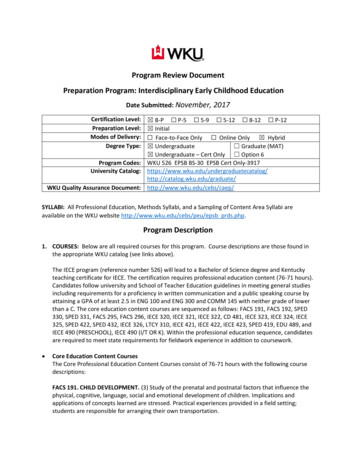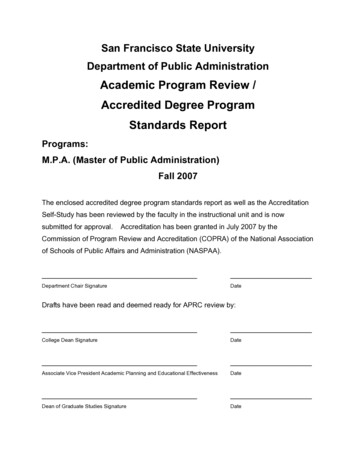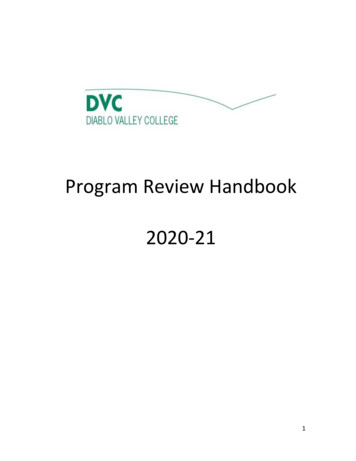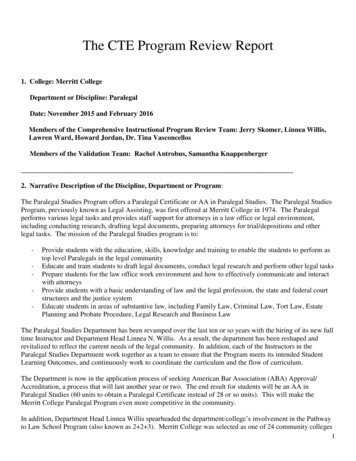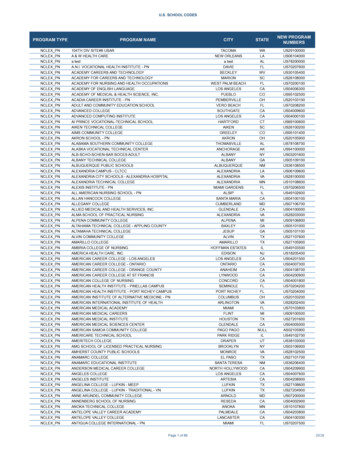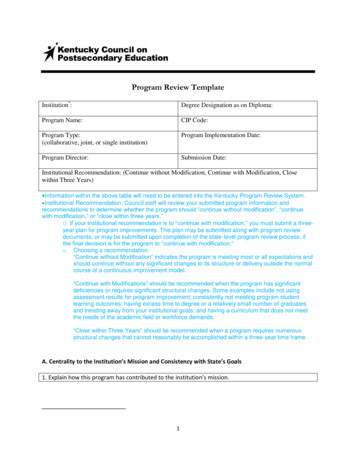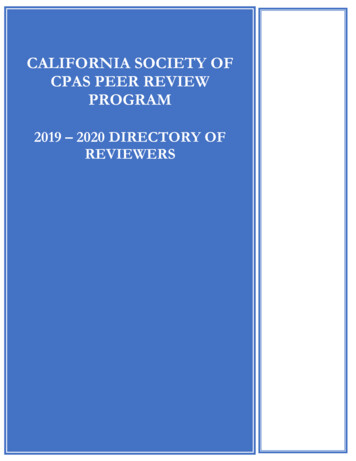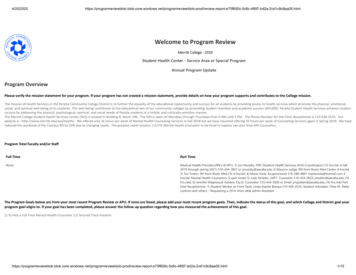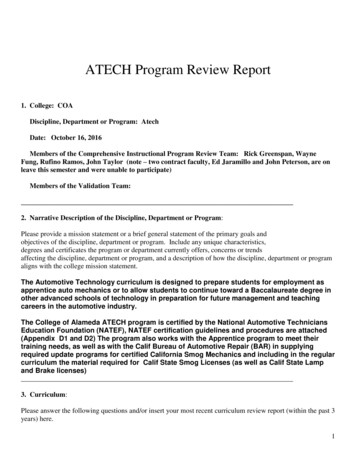
Transcription
ATECH Program Review Report1. College: COADiscipline, Department or Program: AtechDate: October 16, 2016Members of the Comprehensive Instructional Program Review Team: Rick Greenspan, WayneFung, Rufino Ramos, John Taylor (note – two contract faculty, Ed Jaramillo and John Peterson, are onleave this semester and were unable to participate)Members of the Validation Team:2. Narrative Description of the Discipline, Department or Program:Please provide a mission statement or a brief general statement of the primary goals andobjectives of the discipline, department or program. Include any unique characteristics,degrees and certificates the program or department currently offers, concerns or trendsaffecting the discipline, department or program, and a description of how the discipline, department or programaligns with the college mission statement.The Automotive Technology curriculum is designed to prepare students for employment asapprentice auto mechanics or to allow students to continue toward a Baccalaureate degree inother advanced schools of technology in preparation for future management and teachingcareers in the automotive industry.The College of Alameda ATECH program is certified by the National Automotive TechniciansEducation Foundation (NATEF), NATEF certification guidelines and procedures are attached(Appendix D1 and D2) The program also works with the Apprentice program to meet theirtraining needs, as well as with the Calif Bureau of Automotive Repair (BAR) in supplyingrequired update programs for certified California Smog Mechanics and including in the regularcurriculum the material required for Calif State Smog Licenses (as well as Calif State Lampand Brake licenses)3. Curriculum:Please answer the following questions and/or insert your most recent curriculum review report (within the past 3years) here.1
Attach the Curriculum Review Report or Answer these Questions: Have all of your course outlines of record been updated or deactivated in the past three years? If not, listthe courses that still need updating and specify when your department will update each one, within thenext three years.Curriculum is reviewed every five years by an outside certification team as part of the Mater LevelProgram Certification by the National Automotive Technicians Education Foundation (NATEF). SeeAPPENDIX D2 for documentation on how NATEF works. Course outlines have been updatedwhenever required by Curriculum Committee and Ed Code. SEE APPENDIX E.NATEF certification occurs every 5 years, with mid-cycle review every two and a half years.During the NATEF certification, outside reviewers look not only at course outlines, but review lab sheets,lecture plans, lecture presentations, day-by-day plans, and student learning in laboratory situations.They also interview students and call local employers regarding the proficiency of students and formerstudents as automotive technicians. What are the discipline, department or program of study plans for curriculum improvement (i.e., coursesor programs to be developed, enhanced, or deactivated)?Prerequisites, co-requisites, and advisories been validated, mainly based upon issues of safety for ourstudents.Curriculum is constantly being reviewed and improved, primarily to keep up with ever-changingindustry and NATEF standards. Instructors attend curriculum development workshops and trainingregularly, as well as attending California Auto Teachers conferences annually. We are currently workingwith a statewide Industry Driven Regional Collaboratives (IDRC) grant to update/improve alternativefuels curriculum. We also teach a 16 hour fee-based Update classes to smog technicians, which must becreated every two years. Please list your degrees and/or certificates. Can any of these degrees and/or certificates be completedthrough Distance Education (50% or more of the course online)? Which degree or certificate?Degrees/Certificates along with latest update information from Curricunet are listed in Appendix E(none can be completed 50% or more online)4. Assessment:Please answer the following questions and attach the TaskStream “At a Glance” report for your discipline,department, or program for the past three years. Please review the “At a Glance” reports and answer thefollowing questions.“At a glance” printout is Appendix GQuestions:2
How does your discipline, department or program ensure that students are aware of the learningoutcomes of the courses and instructional programs in which they are enrolled? Where are yourdiscipline, department or program course and program SLOs published? (For example: syllabi, catalog,department website, etc. If they are on a website, please include a live link to the page where they canbe found)Included in Syllabi Briefly describe at least three of the most significant changes/improvements your discipline,department or program made in the past three years as a response to course and program assessmentresults. Please state the course number or program name and assessment cycle (year) for each exampleand attach the data from the “Status Report” section of TaskStream for these findings.This is a totally ridiculous question. We assess ALL classes EVERY academic year in May, andwe improve ALL classes every year. We need to keep up with Calif State Bureau of Auto Repairstandards, NATEF standards, and general industry standards (as noted in our advisorycommittee minutes) for EVERY CLASS, EVERY SEMESTER, EVERY YEAR.We’ve attached Appendix H, to show three random “snapshots” from Taskstream, to show thatwe update all our classes every year in numerous ways. Briefly describe three of the most significant examples of your discipline, department or program plansfor course and /or program level improvement for the next three years as result of what you learnedduring the assessment process. Please state the course number or program name and attach the datafrom the “Assessment Findings and Action Plan” section for each example.Another ridiculous question. It’s impossible to know what we will need to do in the next threeyears.We are CONSTANTLY reviewing our curriculum and our courses, and our Taskstream SLOreport is but a tiny part of that process.What we can say as of today is that*We’ve needed to overhaul our lab curriculum to eliminate the need for late model Toyotavehicles, after Toyota took those vehicles back when they terminated their contract with PCCD.*We are currently working on our mid-cycle compliance report to NATEF, reviewing ourcurriculum with our Advisory Committee.*We are starting a new fee based Smog update class in Digital Storage Oscilloscopes, which will beintegrated into our regular curriculum during the coming years*We are working with Calif Automobile Assn, the Peralta Foundation, Elnora Webb, and manyother sources to try to get donations of late model vehicles. If we get those vehicles, our labcurriculum will need to be updated to do work on those vehicles. We are working with MarieHampton in purchasing to see how we could purchase used vehicles using requisition process*We are working with the IDRC grant and will be teaching a 3-unit class (paid for by the grant)on alternative fuel vehicles in the spring. This information will then be incorporated into ourcurriculum, although at present, we don’t have ANY hybrid, electric or fuel cell vehicles on whichto train those students.3
Describe how assessment results for Distance Education courses and/or programs compare to the resultsfor the corresponding face-to-face classes.We don’t teach distance ed classes Describe assessment results for courses with multiple sections. Are there similar results in each section?We have very few multi-section classes. The few that we do have get similar results. Describe your discipline, department or program participation in assessment of institutional leveloutcomes (ILOs).We find this kind of exercise not at all helpful to the success of our students. So we spend as littletime on it as possible.Plus, the only way to evaluate institutional and program level outcomes is to contact students whohave completed a certificate or degree. However, since it is illegal for Student Services to even tellus which students have applied for certificates or degrees until AFTER they have graduated andleft COA, we have had great difficulty assessing program level outcomes with those students.If the administration wishes to evaluate institutional outcomes for COA students who completedegrees and certificates, they are free to contact graduates from our programs and assess them asthey wish. How are your course and/or program level outcomes aligned with the institutional level outcomes?Please describe and attach the “Goal Alignment Summary” from TaskStream.See Appendix I5. Instruction: Describe effective and innovative strategies used by faculty to involve students in the learning process.*Quality lectures*up-to-date labs, with vehicles which reflect the current vehicles on the market*all classrooms have projectors and internet connections*up-to-date equipment, reflecting state of the art used in the trade*regular advisory committee meetings*keeping up with the latest industry standards, as per NATEF and our advisory committee How has new technology been used by the discipline, department or program to improve studentlearning?4
*Professional Development so that faculty can get trained on the latest systems, tools anddiagnostic processes in the field.*purchase and use of state-of-the-art diagnostic equipment in lab settings*purchase and utilize “state-of-the-art” vehicles for trainingNOTE: All these requires substantial commitment to CTE funding by California, Peralta andCOA How does the discipline, department, or program maintain the integrity and consistency of academicstandards with all methods of delivery, including face-to-face, hybrid, and Distance Education courses?*we constantly meet informally to review our classes, our labs, and our standards*we go over one eighth of our curriculum each time we meet with advisory committee (whichmeans we review the entire curriculum every 4 year cycle, since we have 8 areas in which we mustbe certified under NATEF certification)*we undergo rigorous NATEF review of our entire program, including academic standards, everyfive years to maintain “master” program status. This must be done by trained evaluators whohave nothing to do with our program and have been trained by NATEF. How do you ensure that Distance Education classes have the same level of rigor as the correspondingface-to-face classes?no distance ed classes are taught Briefly discuss the enrollment trends of your discipline, department or program. Include the following:o Overall enrollment trends in the past three years5
o An explanation of student demand (or lack thereof) for specific courses.Enrollment “trends” haven’t changed for the last 30 years – when the economy in the Bay Area isbetter, enrollment goes down. That’s true of all Bay Area colleges, that’s true of Peralta, it’s truefor the vast majority of Peralta’s CTE programs and it’s certainly true for Atech.Demand for our beginning courses is always higher than that for our advanced classes.But we have a higher dropout rate from our beginning classes, since many of those students findthe discipline to be more demanding and complex than they may have imagined.Could we “recruit” more students in low-enrollment times? Could we recruit better students?Or students more likely to complete? During the final 5 years of our Toyota program, we sentnot one but two faculty to Toyota’s training workshops on “recruiting,” taught by a “championrecruiter” from a private technical college.Both John Taylor and John Peterson followed the Toyota recruiting system to the letter and ITMADE NO DIFFERENCE IN TOYOTA ENROLLMENT! So in our experience, ‘recruiting’ isnot the answer to low demand.When the overall economy takes a turn for the worse, and there are fewer jobs available inconstruction, fast food, FedEx, etc., then ‘demand’ for Atech classes will get better. Otherwise, inorder to maintain our certification with NATEF, we need to run our current set of classes andcontinue to provide the best, highest quality automotive training available.Invariably, we find that the more advanced the class, the lower the enrollment/demand.This is because, unlike AMT or Nursing or Cosmetology, passing a licensing exam is not requiredto repair vehicles in the state of California. So students drop out of the program and go to workfull-time – typically in the area of auto repair. In our opinion, when a student drops out of ourprogram to work full-time as an auto technician, that’s a mark of program success. It should not6
be a “ding” on enrollment, productivity, success and retention.low quality program.Lower demand isn’t related to ao Productivity for the discipline, department, or program compared to the collegeproductivity rate.Please insert the data chart here - SEE CHARTS ABOVECollege productivity rate 15.29o Salient factors, if known, affecting the enrollment and productivity trends youmention above.see above Are courses scheduled in a manner that meets student needs and demands? How do you know?We’ve tried every imaginable scheduling various over the last 35 years that Rick has been here, andenrollment trends haven’t changed. The current schedule allows the most efficient use of thelaboratory and lecture facilities available, along with faculty availability. Recommendations and priorities.Maintain NATEF certification; continue to involve advisory committee.Keep up the good work!!6. Student Success: Describe course completion rates (% of students that earned a grade “C” or better or “Credit”) in thediscipline, department, or program for the past three years. Please list each course separately. How dothe discipline, department, or program course completion rates compare to the college coursecompletion standard?College course completion standardPlease insert the data chart here or complete the section below.7
Department/discipline course completion rates:Discussion:These rates are typical of CTE classes such as Atech. Higher withdrawal rates and lowerretention are in the beginning classes; the more advanced classes are smaller with higher retentionand completion rates. Describe course completion rates in the department for Distance Education courses (100% online) forthe past three years. Please list each course separately. How do the department’s Distance Educationcourse completion rates compare to the college course completion standard?No Distance Ed Classes are taught Are there differences in course completion rates between face to face and Distance Education/hybridcourses? If so, how does the discipline, department or program deal with this situation?N/A Describe the discipline, department, or program retention rates (After the first census, the percent ofstudents earning any grade but a “W” in a course or series of courses) for the past three years. How doesthe discipline, department, or program retention rate compare to the college retention standard?College retention standard 52%Discipline, department, or program retention rates8
Discussion:In general, retention is higher in smaller, more advanced classes. It is lower in larger, beginningclasses. This is typical of all CTE areas. What has the discipline, department, or program done to improve course completion and retention rates?What is planned for the next three years?The same as we’ve done for the last 3 years, and the same as we plan to do for the nextthree years and the three years after that, and so on!*Maintain quality of program*Keep up with changes in industry*Professional development for faculty*Continue to maintain NATEF master program certification status*Update equipment, such as hybrid vehicles, for student labs*Update diagnostic equipment to match industry standards9
What has the discipline, department, or program done to improve the number of degrees and certificatesawarded? Include the number of degrees and certificates awarded by year, for the past three years.What is planned for the next three years?We are proud of our rates of degrees and certificates and don’t see any major areas thatneed changing. Of course, curriculum content will continue to change to keep up with theindustry. And with enrollment currently down, we expect that the number ofdegrees/certiificates will also drop accordingly.10
7. Human, Technological, and Physical Resources (including equipment and facilities): Describe your current level of staff, including full-time and part-time faculty, classified staff, andother categories of employment.Full-time faculty headcount 5 full time; two are on leave this semesterPart-time faculty headcount Two this semester, three next semesterTotal FTEF faculty for the discipline, department, or program 4.63 this semesterFull-time/part-time faculty ratio 5 (2 on leave) to 2 (fall) or 3 (spring)Classified staff headcount One11
Describe your current utilization of facilities and equipment.Our facility is used pretty much all day, M-F, plus three to four evenings a week.We also teach smog update classes on Saturdays and Sundays, about once every month ortwo.We often have three classes in labs at the same time, so the equipment gets heavy use,which is why it is important to have consistent maintenance programs and to replacedaged, outdated, broken and worn out equipment on a regular basis. What are your key staffing needs for the next three years? Why? Please provide evidence to supportyour request such as assessment data, student success data, enrollment data, recommendations fromyour advisory committee, changes in certification requirements, and/or other factors.Our staffing levels are well matched at present to our student demand. What are your key technological needs for the next three years? Why? Please provide evidence tosupport your request such as assessment data, student success data, enrollment data,recommendations from your advisory committee, changes in certification requirements, and/or otherfactors.Please see NATEF certification standards (Appendix D1 and D2) for the evidencesupporting our requests for new technology – new equipment, new vehicles, new trainers,new diagnostic tools, etc.If anyone can predict the changes in automotive technology three years into the future,they should probably be working for Tesla or Google!Among the upcoming changes in automotive technology:*Increased use of navigation and onboard camera systems*”heads up” displays of data12
*Radar*Lidar (Laser Radar)*Lane control*Increased stability controls*Engines which turn off and on every time vehicle comes to a stop*Self driving vehicles*Electric vehicles*Plugin Hybrids*Fuel Cell vehiclesWe need to develop curriculum in all these areas as they are added to our instructionalprogram.Another issue is what curriculum areas we eliminate to make room for the changes?That will be based on industry input from our advisory committee and based on NATEFcertification standardsOverall, it’s all we can do to keep up, one-year-at-a-time. What are your key facilities needs for the next three years? Why? Please provide evidence tosupport your request such as assessment data, student success data, enrollment data,recommendations from your advisory committee, changes in certification requirements, and/or otherfactors.Facility improvements don’t need any supporting data – they are just common sense sothat students can learn in a safe and comfortable environment.All classrooms need functioning climate control systems.heat in the winter and no cooling in the summer.At present there is essentially noThe vehicle exhaust system in the building is 40 years old, they don’t make parts for thepumps any more, and yet Peralta refuses to replace anything as long as it continues towork.All the vehicle lifts need regular servicing, something PCCD refus
Prerequisites, co-requisites, and advisories been validated, mainly based upon issues of safety for our students. Curriculum is constantly being reviewed and improved, primarily to keep up with ever-changing . This is because, unlike AMT or Nursing or Cosmetology, passing a licensing exam is not required .
